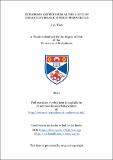Exploring azetidinium as the A-site in organic-inorganic hybrid perovskites
Date
30/11/2021Author
Grant ID
CSC No. 201603780020
Metadata
Show full item recordAltmetrics Handle Statistics
Altmetrics DOI Statistics
Abstract
Organic inorganic hybrid perovskites (OIHPs) have appealing optoelectronic properties.
As sample preparation is relatively straightforward, there are opportunities to investigate
novel compositions and structures. This thesis concerns the synthesis, structure and
optoelectrical properties of OIHPs with azetidinium as an A-site cation.
Azetidinium [(CH₂)₃NH₂⁺, Az] is a four-member ring ammonium, and its size is
calculated to be promising as an A-cation for OIHPs. A stable 6H hexagonal perovskite
AzPbBr₃ was synthesised and analysed, and its bandgap was determined to be 2.81 eV.
On cooling, AzPbBr₃ undergoes a symmetry lowering distortion which was identified by
variable temperature PXRD and dielectric spectroscopy. An anisotropic change in lattice
parameters on cooling marked a phase transition likely driven by the Pb⋯Pb repulsion in
the face sharing octahedra.
Compositional and structural analyses were performed on precipitation synthesised and
mechanosynthesised OIHPs Az₁₋ₓFAₓPbBr₃ and Az₁₋ₓMAₓPbBr₃ (0 ≤ x ≤ 1). For samples
obtained from precipitation synthesis, the actual FA% or MA% in the precipitate was
found to be less than the nominal composition in the reaction solution. No such mismatch
was found for mechanosynthesised samples. PXRD indicated partial solid solution
formation for Az-rich and MA- or FA-rich compositions, separated by an intermediate
two-phase region. The result suggests the extent of the solid solution of halide perovskites
is dependent only on the average A-cation size; the size mismatch is less of an influence.
This is in contrast to solid solution formation observed in oxide perovskites.
A tuneable bandgap was achieved ranging from 2.00 eV (AzPbI₃) to 3.41 eV (AzPbCl₃)
for the mixed halide perovskite AzPbBr₃₋ₓXₓ (X = Cl or I, 0 ≤ x ≤ 3). The structural
analyses revealed a complete 6H solid solution for AzPbBr₃₋ₓClₓ in comparison to the
structural progression from 6H, 4H to 9R polytypes, when varying the halide composition
from Br (x = 0) to I (x = 3) in AzPbBr₃₋ₓIₓ. A linear variation in unit cell volume as a
function of anion average radius was observed not only within the solid solution of each
polytype (following Vegard’s law) but continuously across all three polytypes.
Preliminary results on the synthesis and structural analysis indicate that Az₂PbBr₄ adopts
the 𝘯 = 1 Ruddlesden-Popper structure while azetidinium bismuth bromide has a 1D chain
structure. Detailed structural and optical analysis are planned in future projects.
Type
Thesis, PhD Doctor of Philosophy
Collections
Description of related resources
Exploring azetidinium as the A-site in organic-inorganic halide perovskite (thesis data) Tian, J., University of St Andrews, 1 Nov 2022. DOI: https://doi.org/10.17630/f1f27a88-f5a0-4a56-ba2a-33bc37a0f640Related resources
https://doi.org/10.17630/f1f27a88-f5a0-4a56-ba2a-33bc37a0f640Items in the St Andrews Research Repository are protected by copyright, with all rights reserved, unless otherwise indicated.

